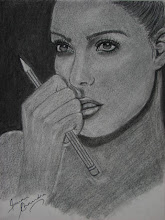
To all my friends, I would apologise for wishing you all little late as I wanted to send my wishes through a painting.
Here you can see a painting on 30 x 40 cms canvas, with acrylic paints. The canvas is 100% cotton and unbleached.



 The famous Dagdusheth Halwai Ganpati Idol brought from at my sisters house. The thermacoal frame has been designed by me. It was fun to do that. Next year will get more time to do an elaborate one.
The famous Dagdusheth Halwai Ganpati Idol brought from at my sisters house. The thermacoal frame has been designed by me. It was fun to do that. Next year will get more time to do an elaborate one. Bringing home Ganesha
Bringing home Ganesha


MOONCHWALA JAT

PONGA PANDIT

CHARLIE ANNA (cool cap n glasses - dude)
Excellent table tops......look good if kept together!!!!!!!!!!!!!
Take a look

Thank you all.........
Stay fit n stay safe!!!!!!

This was inspired from a picture from webshots. I thought was perfect for this day. I have used the Indian flag colours in this painting. I felt this had a look of Mother India. It symbolises the richness of its diversity.
 This is taken from wikipedia
This is taken from wikipedia
Janmaashtami, popularly known in Mumbai and Pune as Dahi Handi
is celebrated with enormous zeal and enthusiasm. The handi is a clay pot filled with buttermilk that was positioned at a convenient height prior to the event; the topmost person on the human pyramid tries to break the handi by hitting it with a blunt object, and when that happens, the buttermilk is spilled over the entire group, symbolizing their achievement through unity. Various Handis are set up locally in several parts of the city, and groups of youngsters, called Govinda, travel around in trucks trying to break as many handis as possible during the day.
Many such Govinda Pathaks compete with each other, especially for the handis that dole out hefty rewards. The event, in recent times, has gathered a political flavor, and it is not uncommon for political parties, and rich community groups to offer prizes amounting to lakhs of rupees.
Some of the most famous handis are at Dadar, Mazgaon, Lalbaug and some in Thane a neighboring district of Mumbai and Babu Genu, Mandai in Pune.
Cash and gifts are offered for Govinda troops to participate; for over 4000 Handis in Mumbai, 700 Govinda troops compete for the prizes.
This custom follows the habit of Lord Krishna who used to steal butter in this manner from villagers along with his friends. The reason for this is that Gokul; the place where lord Krishna spent his childhood used to generate a lot of milk and the people used to sell it in Mathura, thus depriving their children from milk and butter which is very essential for young boys and girls.
In South India, Janmashtami or Gokulashtami is celebrated with prayers, devotional renditions and offering of fruits and special prasadams to Lord Krishna. In some houses, a typical setting of 'Gokulam' is arranged with mud images of Devaki, Vasudeva with little Krishna perched in a basket on his head, a cow, besides other things related to Krishna's legends.
This painting is also among one of the faces of a woman....as a mother.
I had reserved this painting for today as it is appropriate to publish it in my post on the day of Lord krishnas Birth.
I have made it on 30 cms x 30 cms acid free canvas. I have added some glitter to the painting...I hope it is visible. I feel it adds more feel to it. If you notice the background has been painted with sponge dipped in flame colour and on that sponge with green colour has been printed. I just tried my hand on this as I wanted the background somewhat like a wall paper look.....
Hare Krishna Hare Krishna Krishna Krishna Hare Hare
Hare Ram Hare Ram Ram Ram Hare Hare
As we all are celebrating Janmashtami, we should also remember to be careful about the swine flu. I hope everyone takes precautionary measures....
Take care n stay fit.....
I m in process of restructing my blog......hopefully I am able to do complete before Ganesh Festival....
Also wanted to know if you all like the name Domestic Goddess or I should change it to SuzCorner....as all my friends and family call me Su so I thought to keep it SuzCorner.......
Do tell me what you guys think of the name....
Love Su
Raja Ravi Varma (1848-1906) was born in Kilimanoor Palace as the son of Umamba Thampuratti and Ezhumavil Neelakandan Bhattathiripad. At the age of seven years he started drawing on the palace walls using charcoal. His uncle Raja Raja Varma noticed the talent of the child and gave preliminary lessons on painting. At the age of 14, Ayilyam Thirunal Maharaja took him to Travancore Palace and he was taught water painting by the palace painter Rama Swamy Naidu. After 3 years Theodor Jenson, a British painter taught him oil painting.
Most of his oil paintings are based on Hindu epic stories and characters. In 1873 he won the First Prize at the Madras Painting Exhibition. He became a world famous Indian painter after winning in 1873 Vienna Exhibition.
Many of his oil paintings are classic and his unique Indian style has later influenced artists and designers worldwide, including me.


This was also made on canvas and portrays a confident woman of today.

yet another one which I feel is special as this is my daughter's favourite and mine too.....